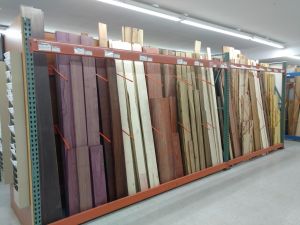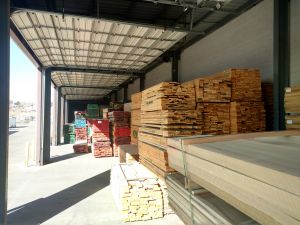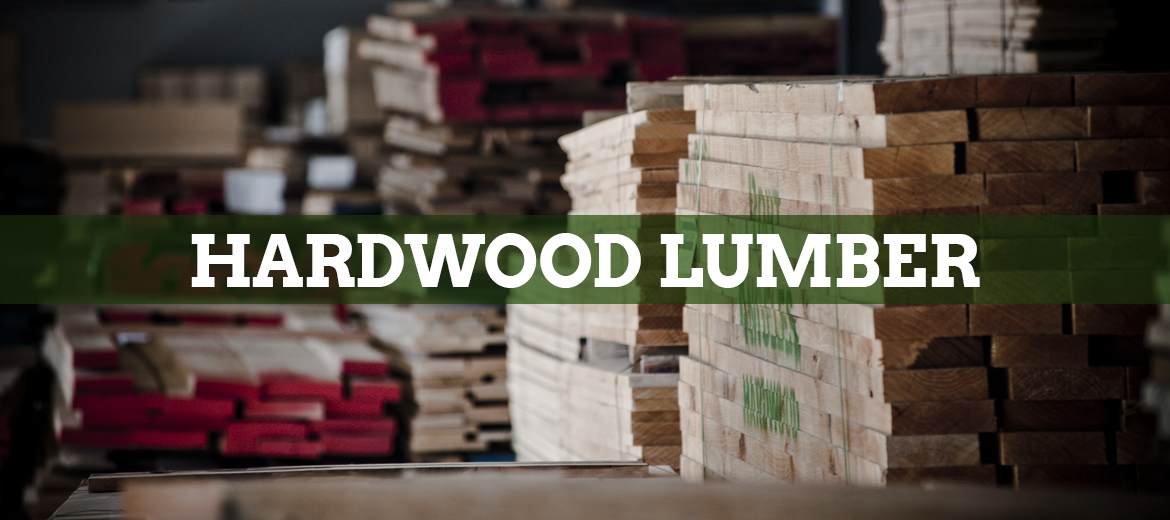- Barnwood
- Birch
- Cherry
- Hickory
Minimum National Grade Rules
FAS
Hardwood's best grade yields about 85-90% clear cuttings. Most boards are 6" and wider, 8' and longer. (Exception: Walnut is 5" and wider, 6' and longer.) Rough FAS lumber is graded from the board's poorer side
FAS 1 FACE & BETTER
Subject to the same grading rule as FAS except that the board is graded from the better side and back side must grade at least No. 1 Common.
SELECTS & BETTER
Similar to FAS 1 Face & Better except that the minimum allowable board size is 4" and wider, 6' and longer. Backside may grade No. 1 Common or Sound.
SELECTS
4" and wider, 6' and longer. Better side grades FAS, reverse side grades No. 1 Common. Short and narrow boards are usually clear.
CLEAR 1 FACE SHORTS
4" and wider, 4'-7' long. For short clear cuttings - such as face frames and furniture parts.


Glossary
Grade
Term that defines the quality of the wood. The National Hardwood Lumber Association (NHLA) has set a standard grading scale. There are many criteria and restrictions, including number of cuttings, size of cuttings, and size of lumber.
Firsts and Seconds (FAS)
Generally the highest NHLA grade available and it must be 83%-100% clear-wood cuttings. Clearness is measured in large rectangular areas called cuttings and it is graded on the best face, however both faces of the board must meet the minimum requirement for FAS. Provides user with long, clear cuts and is best used for high quality furniture, interior joinery and solid wood mouldings.
FAS One Face (F1F)
The better face must meet all FAS requirements, while the poor face must meet the requirements of Number 1 Common grade, thus ensuring the buyer of at least one FAS face.
Select Grade NHLA
Grade that has FAS quality on the good side and No. 1 Common quality on the poor side. It is virtually the same grade as F1F except for the minimum board size required, typically too short and narrow to be F1F for FAS. Selects are associated with the northern regions of the USA and are frequently shipped with FAS grade lumber.
Number 1 Common (NO. 1C)
NHLA grade which must be 67% clear on both faces of the board. It is often referred to as Cabinet grade because of its adaptability to the standard sizes of kitchen cabinet doors in the USA. There are little to no natural defects such as worm holes or reverse fiber on either face. There are little to no machine defects such as planer chatter or hit and miss. Some pin knots are allowed with no dead knots.
Rustic
Character marked hardwoods shall admit any kind, number or distribution of the following characteristics incident to tree growth; heartwood, sapwood, knots, burls, swirls or other fiber irregularities, bird pecks, holes or grooves, knots not exceeding 3" in diameter and color streaks or spots, and light stain, but the cuttings shall not admit decay, loose knots, excessive pith, shake, or split.
Proprietary Grade
Grades designed for specific cutting and appearance attributes.
First European Quality (FEQ)
This grade refers specifically to teak, generally equal to or even better than FAS grade and the highest grade available; free from sapwood, bee holes and loose knots.
Alder Grades
Alder Superior is our most flexible alder grade with the highest yield. Combines “Select & Better” and FAS boards with backs that are Cabinet grade or better, yielding 83-1/3 clear face cuttings with minimum cutting sizes of 3” x 6’ or 4” x 3’. Alder Sup is ideal for uses requiring long, wide clear-face cuttings or multiple rips and chops.
Alder Rustic grade is designed for rustic and distressed furniture and cabinetry applications. Alder Rustic yields 75% structurally sound fiber, with minimum cutting size of 3” x 2’. Black knots limited to 1” diameter in the cutting area.
Alder Premium is an appearance and structural grade with scattered sound and unsound defects. Each Alder Premium board yields a high percentage of long, sound cuttings. 5/4 exhibits larger defects but maintains its structural integrity due to added thickness.
Eastern Pine Grades
C Select is the highest NeLMA Pine grade. While some of the pieces are clear, most pieces have minor characteristics which do not affect their high appearance or quality. Material of this grade is usually used for natural finishes in fine woodworking or interior trim. Typically, one sound, tight pin knot (maximum 1/2″) per 4 surface feet is allowed.
Furniture Grade Eastern White Pine
Lumber selected for its abundance of tight red knots. This lumber is graded much like a #1 Common Hardwood with the tight red knots not counting as a defect. The tight red knots are to be utilized in the finished product.
Woodworking Terms
Air Dried (AD)
Lumber that has been dried by exposure to air, usually in a yard, without artificial heat.
Kiln Dried (KD
Lumber that has been dried in a kiln with the use of artificial heat; seasoned. Freshly cut green lumber may be sold green, air dried, or dried in a kiln to accelerate removal of the moisture in the wood. Drying wood in a kiln is an art to ensure that the wood dries evenly to retain its strength and aesthetic properties. Different species dry at different rates. Kiln dried lumber commands a higher price than green or air dried lumber.
Board Foot (BD. FT. OR BF
The volume of a board 12″ long, 12″ wide, and 1″ thick or the equivalent (144 cubic inches of wood).
Linear Foot (LN. FT. OR LF
System of measuring length.
L.T.L. (LESS THAN LOAD)
An LTL shipment is when there is less than a truck load of product to be shipped at one time.
Burl
A swirl or twist in grain of the wood, which usually occurs near a knot, but is not a knot.
CHECK
A lengthwise separation of the wood that usually extends across the rings of annual growth and commonly results from stresses set up in wood during seasoning.
Conditioning
The exposure of a material to the influence of a prescribed atmosphere for a stipulated period of time or until a stipulated relation is reached between material and atmosphere. Also referred to as “acclimating.”
Cup
A distortion of a board in which there is a deviation from a straight line across the width of a board.
Density
As usually applied to wood of normal cellular form, density is the mass of wood substance enclosed within the boundary surfaces of a wood-plus-voids complex having unit volume. It is variously expressed as pounds per cubic foot, kilograms per cubic meter, or grams per cubic centimeter at specified moisture content.
Dressed
Lumber that has been trimmed and planed at the sawmill.
Figure
The pattern produced in a wood surface by annual growth rings, rays, knots, deviation from regular grain, such as interlocked and wavy, and irregular coloration.
Grain
The direction, size, arrangement, appearance or quality of the fibers in sawn wood.
Close-Grained
Wood with narrow, inconspicuous annual rings. The term is sometimes used to designate wood having small and closely spaced pores, but in this sense the term “fine textured” is more often used.
Coarse-Grained
Wood with wide conspicuous annual rings in which there is considerable difference between springwood and summerwood. The term is sometimes used to designate wood with large pores, such as oak, ash, chestnut and walnut, but in this sense the term “coarse textured” is more often used.
Cross-Grained
Having fibers running irregularly from a line parallel to the sides of a piece of wood. Also referred to as “uneven” grain, cross-grained may be either diagonal, spiral, or a combination of the two.
Curly-Grained
Wood in which the fibers are distorted so that they have a curled appearance, as in “birdseye” wood. The areas showing curly grain may vary up to several inches in diameter.
Diagonal-Grained
Wood in which the annual rings are at an angle with the axis of a piece as a result of sawing at an angle with the bark of the tree or log. A form of cross-grain.
Edge-Grained
Lumber that has been sawed so that the wide surfaces extend approximately at right angles to the annual growth rings. Lumber is considered edge-grained when the rings form an angle of 45° to 90° with the wide surface of the piece.
End-Grained
The grain as seen on a cut made at a right angle to the direction of the fibers (e.g., on a cross section of a tree).
Fiddleback-Grained
Figure produced by a type of fine wavy grain found, for example, in species of maple; such wood being traditionally used for the backs of violins.
Fine-Grained
Compact and smooth to the touch.
Flat-Grained
Lumber that has been sawed parallel to the pith and approximately tangent to the growth rings. Lumber is considered flat grained when the annual growth rings make an angle of less than 45° with the surface of the piece.
Interlocked-Grained
Grain in which the fibers put on for several years may slope in a right-handed direction, and then for a number of years the slope reverses to a left-hand direction, and later changes back to a right-handed pitch, and so on. Such wood is exceedingly difficult to split radially, though tangentially it may split fairly easily.
Open-Grained
Common classification for woods with large pores, such as oak, ash, chestnut and walnut. Also known as “coarse textured.
Plainsawn
Another term for flat-grained lumber.
Quartersawn
Another term for edge-grained lumber.
Side-Grained
Another term for flat-grained lumber.
Spiral-Grained
Wood in which the fibers take a spiral course about the trunk of a tree instead of the normal vertical course. The spiral may extend in a right-handed or left-handed direction around the tree trunk. Spiral grain is a form of cross grain.
Straight-Grained
Wood in which the fibers run parallel to the axis of a piece.
Vertical-Grained
Another term for edge-grained lumber.
Wavy-Grained
Wood in which the fibers collectively take the form of waves or undulations.
Hardwood
Any close-grained wood from deciduous trees. Generally one of the botanical groups of trees that have broad leaves in contrast to the conifers or softwoods. The term has no reference to the actual hardness of the wood.
Heartwood
The wood extending from the pith to the sapwood, the cells of which no longer participate in the life processes of the tree. Heartwood is generally darker than sapwood, but the two are not always clearly differentiated.
Janka Hardness
A scale that measures of the relative hardness of wood. The test measures the force required to push a steel ball with a diameter of 11.28 millimeters (0.444″) into the wood to a depth of half the ball’s diameter (the diameter was chosen to produce a circle with an area of 100 square millimeters). In the United States, the measurement is in pounds-force. It is one of the best measures of the ability of a wood species to withstand denting and wear. It is also a good indicator of how hard a species is to saw or nail.
Lumber
Solid wood that has been sawn to a particular size. The product of the saw and planing mill not further manufactured than by sawing, resawing, passing lengthwise through a standard planing machine, crosscutting to length, and matching.
Nominal Size
As applied to timber or lumber, the size by which it is known and sold in the market often differs from the actual size.
Rough Lumber
Lumber that has not been dressed (surfaced) but which has been sawn, edged, and trimmed.
Surfaced Lumber
Lumber that is dressed by running it through a planer. Lumber that is Surfaced Four Sides (S4S) means that all four faces of the board have been dressed. Boards can also be Surfaced One Side (S1S) or Surfaced Two Sides (S2S).
Mineral Streak
An olive to greenish-black or brown discoloration.
Moisture Content (M.C.)
The weight of water contained in wood expressed as a percentage of the weight of the oven dry wood. Most hardwoods in the United States are produced to standards developed by the National Hardwood Lumber Association (NHLA). No single moisture content, however, is specified for hardwoods because the uses are more specialized. The moisture content must be specified by the buyer and agreed to by the seller; a 10-12% moisture content specification is common.
Net tally
Otherwise known as a dried tally. The board footage of lumber figured when the board is seasoned.
Old Growth
A forest of mature or over mature timber that is beyond its peak growing period.
Pin Knot
A knot which does not exceed 1/8″ in average diameter.
Pith
The small soft core occurring in the structural center of the log.
Plain-Sawn
Plain-sawn hardwood boards are produced by cutting tangentially to a tree’s growth rings, creating the familiar “flame-shaped” or “cathedral” pattern. This method also produces the most lumber from each log, making plain-sawn lumber a cost effective design choice.
Pocket
An excessive local accumulation of resin or gum in the wood.
Quarter-Sawn
Quarter-sawing means cutting a log radially (90-degree angle) to the growth rings to produce a “vertical” and uniform pattern grain. This method yields fewer and narrower boards per log than plain sawing, boosting their cost significantly. Quarter-sawn boards are popular for decorative applications.
Reforestation
The natural or artificial restocking of an area with forest trees.
Resawing
The process of sawing lumber in two lengthwise, parallel to the wide face. It is usually, though not always, done through the middle of the board, producing two equal sized boards, each approximately half the thickness of the original. Resawing changes the thickness of the lumber but not its width.
Ripping
The process of sawing lumber in two lengthwise perpendicular to the wide face. Ripping changes the width of the lumber but not its thickness.
Sapwood
The living wood of pale color near the outside of the log.
Seasoning
Removing moisture from green wood to improve its serviceability.
Shrinkage
The contraction of wood fibers caused by drying below the fiber saturation point (usually around 25-27% M.C.). Values are expressed as a percentage of the dimension of the wood when green.
Softwood
Any soft, light-textured wood of a coniferous tree.
Species
A commercial name assigned to tree.
Specific Gravity
As applied to wood, the ratio of the ovendry weight of a sample to the weight of a volume of water equal to the volume of the sample at a specified moisture content (green, air-dry, or ovendry). This term applies to the wood’s ability to float or sink in water.
Split
A lengthwise separation of the wood, due to the tearing apart of wood cells.
Sustained harvest
A level of harvest that does not exceed annual growth, so that at least as much is available for harvest in 50 years as today.
Warp
Warp is any variation from a true or plane surface. Warp includes bow, crook, cup and twist, or any combination thereof.
Weathering
The mechanical or chemical disintegration and discoloration of the surface of wood caused by exposure to light, the action of dust and sand carried by winds, and the alternate shrinking and swelling of the surface fibers with the continual variation in moisture content brought by changes in the weather. Weathering does not include decay.
Yield
The proportion of the log converted into lumber.



